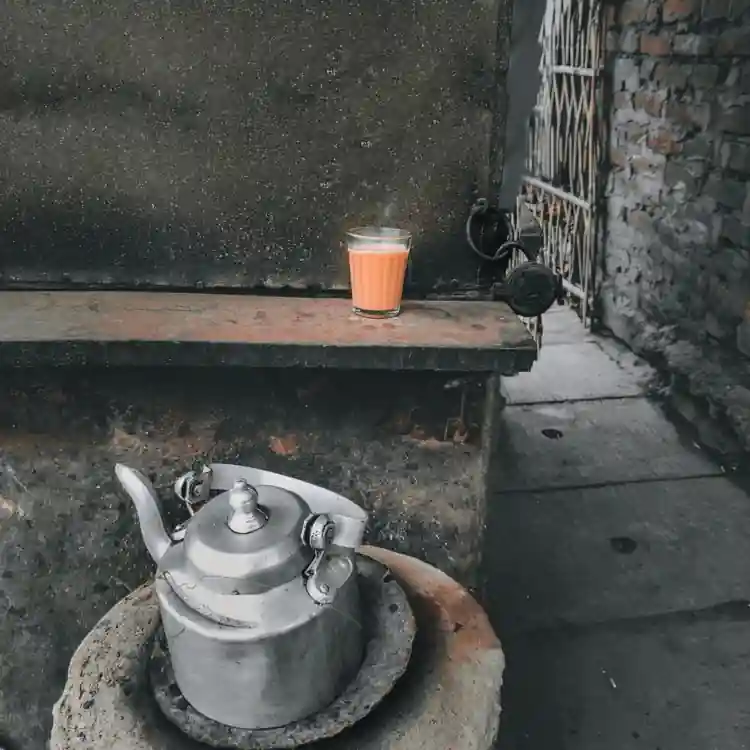
I often cross the street to a shack clinging to the footpath, nestled beside a ramshackle temple and a green goods rake parked on wet rails. Rust and roughness seeps in to its walls. The only paint it has ever known is smoke from coal embers and steam. Its kettles and made-in-china glasses are painfully clean. The tea comes in two varieties: red, milky and sweet, or pale ruby, peppery, invigorating. Though, I prefer coffee, this is Assam; the land of laal-cha, after all.
The scrawny chai wallah says his family has been making tea for decades. I take it with a pinch of salt. But then again, we Indians and our inscrutable neighbours, the Chinese, are ancient people. Everything here seems to boast a 5000 years old history, from UAVs to infallible cures or raging pandemics. We are both societies with shared complicated histories, acute memories of past tyrannies and blessed with a selective nostalgia. Somewhere within this shared past lies buried the story of how cha became a cure-all for our everyday malaise.
***
‘Tea’ generally refers to a concoction of leaves of the Camellia sinensis plant boiled in water. It originates from a small tree, native to parts of Southern China and the Indo-Burmese region. Tea was probably first taken as a medicine alongside other herbs in Yunnan, during the Shang era (1500 BC). Later it was popularised as a beverage in Sichuan and then across China during the Tang dynasty (760 CE). Legends, however, place the origin story to an earlier period. The emperor Shen Nung (around 2700 BC) and an inattentive servant are credited with serendipitously discovering the delights of tea while boiling water below a bush.
India claims ownership too. One grisly legend ties it to the monk Bodhidharma of Shaolin fame, who may have been Tamil, and who may once have cut off his eyelids to stay awake. His fallen eyelids grew in to the first tea plants. Another speculation suggests that tea was one of the fabulous herbs that grew on the Sanjeevani hill that Hanuman heroically lugged to Lanka to revive a mortally stricken Lakshmana. This story does present a rather neat geographical solution. Tea grows primarily in the eastern Himalayan region and Sri Lanka and also the Nilgiris, where presumably some bits fell off on the way. There are also studies that explore the possiblity of tea as the legendary ‘Soma’ drink of the Vedas. More credible tales refer to medicinal brews used in the courts of emperors like Harsha and Ashoka.
Historically though, the Indian origins of tea likely lie in the verdant North East regions of India. The Sing Pho people were brewing and cooking with smoked and fermented wild tea leaves (falap) packed in bamboo tubes way back during the 12th century. Similiar to the early Chinese. The Sing Pho people migrated from Tibet to Southern China and then in to Burma and NE India. Today the Sing Pho live in small numbers in Upper Assam and Arunachal Pradesh. Their drink is also believed to have been adopted by the Tai-Ahom people, who themselves arrived in Assam from South China in 1228 to establish a kingdom that would then significantly shape Assam’s history. Outside of the NorthEast, tea was only known in trading towns with access to China, valued as a cure for minor ailments. It wouldn’t be until much later that tea would truly captivate India.
***
Tea was a Silk Road fable till the first Portuguese ships reached China in the mid 1500s. The Dutch followed and from them, the British got their first taste. Initially, extolled for its restorative properties and restricted to the aristocratic classes, the drink gradually became an irresistible habit across Europe. By the 1830s, Europeans were gulping down a staggering 40 million tonnes – all of it imported from China.
The Chinese shrouded the tea trade in an air of myth and mystery. For a long time, Europe knew nothing about the tree that bore this elixir. Unaware that black and green tea came from the same leaf, or that the Chinese were adding poisonous dyes to enhance the colour of green tea.
The East India Company exchanged shiploads of silver for this precious, aromatic cargo. However, during the 1830s, when the Dutch and British went to war, silver and consequently tea became scarce and prohibitively expensive as there was nothing else that China needed from Britain. Or so they thought. The Company had lost its monopoly but not its thirst for tea. Opium began to be grown in swathes in the Gangetic basin through to Bengal and parts of the Malwa Plateau, at the expense of local crops. To be smuggled in to China through Canton in exchange for tea. Essentially, the Company became a drug cartel, addicting an entire nation to sustain their own addiction to tea – a cruel irony indeed. This subsequently led to the Opium wars (1839), and the ceding of Hong Kong – a time in history so evocatively captured in Amitav Ghosh’s Ibis trilogy.
What is less known though is that tea consumption was also promoted as a way to consume sugar, a commodity produced in abundance on slave driven cane plantations in Central America and the Caribbean.
***
This was also a period of churn in Assam. The 600-year old Ahom Empire led by Purandar Singha was on its last legs battling Burmese incursions. Enter, Maniram Dutta Baruah. Maniram’s family were affiliated to the Ahom and lived a decade in Bengal during the Burmese invasions. He returned to Assam with British blessings and repaid them by leading some Scottish adventurers to the Sing Pho people and their wild tea in 1824. The Assamese tea bushes (Camellia sinensis assamica) possessed broader, thicker leaves and offered a distinctively different quality compared to their Chinese counterparts. These plants were at home here in hotter, flatter areas, rather than the Chinese variety that was suited to higher altitudes and colder climes.
The Company moved in with remarkable speed. In 1826, the Company acquired most of Assam, Manipur and parts of Burma through the dubious Yandaboo treaty. Oddly enough, it was signed with the Burmese invaders with no reference to the Ahom or other local entities ruling different regions at that time! Soon, forests were being mown down across Upper Assam. Ningroo la, a Sing Pho chief was reputedly one of the earliest planters. The first British tea garden was established in Chabua (literally ‘tea-garden’ and today home to a Sukhoi squadron) in 1837. The first batch of Indian tea was shipped to London a year later.
Separately, a few thousand saplings and a handful of tea workers smuggled out from China in the early 1850s lead to the establishment of extensive tea gardens on the slopes of Darjeeling and later the Nilgiris.
***
Maniram served as Prime Minister to Purandar Singha before becoming the Dewan of the Assam Tea Company in 1839. However, differences with the British led him to quit and establish the first ever tea garden by an Indian entrepreneur at Cinnamara (1845) near Jorhat. Locals will offer you two versions for the name’s origin: either “Cheena-maara,” meaning “killing of the Chinese” (referring to slain Chinese planters), or a Tamil name given by a British officer, “Chinna-mara” or “small tree.”
The burgeoning tea industry brought its share of problems. The Ahom and the proud indigenous Assamese tribes were protective of their land and looked upon this growing industry with suspicion. There was open resistance to forests being cut and the harsh working conditions in the gardens. Rebellions were stubbed out with armed force. To solve the problem of work, the Company brought in malleable Marwaris and educated Bengalis to manage the tea gardens, factories and other civil administration jobs. They would also forcibly march thousands of tribals (Santhal, Munda etc.) from Central and Eastern India to work as ‘indentured contract labour’ in these gardens. In reality, they were treated no better than slaves. These so-called ‘tea tribes’, having lived through terrible exploitation, high mortality and little contact with outside world till recent times, still work in Assam’s tea gardens! Some unintended aftermaths remain to this day – a deeply ingrained resentment of ‘outsiders’ and the decimation of local wildlife.
Meanwhile, Maniram sought to restore Ahom rule. His growing conflict with the Company led to the seizure of his Cinnamara estates. In 1857, during the Indian Rebellion, he was captured while organizing an armed uprising under the banner of Kandarpeswar, son of Purandar Singha, the last Ahom king. Maniram ‘Dewan’ was publically hanged at Jorhat in February, 1858, dying a folk hero and proclaimed as Kalita-raja (king).
***
Britain was steadily controlling its own tea imports and exports now. They claimed India as the origin land; its tea of higher purity, quality and taste. The advent of railways, as a consequence of discovery of oil and coal in the 1860s, accelerated this growth further. By the 1880’s, Assam and India had upstaged China as the world’s leading tea producer. Increased production and lower prices made tea a drink for the masses.
Even so, when the Great Depression of the 1930s arrived there was a glut of tea in European markets. The Company needed a huge new market, sparking a remarkable marketing campaign worthy of study in history and business classes. In the early 1900s, only a select lot of Indians had tasted tea. Coffee, known for centuries along the western coast, was an accepted beverage. But large swathes of coffee plantations in the South had been decimated by leaf rust outbreaks and tea began to dominate the Nilgiris.
A Tea Association was formed to promote tea consumption, particularly among the “classes.” To the middle and upper class, it was promoted as a symbol of health and refinement backed by imagery of English gentry consuming it in serene tea gardens. For the lower working class, it was a positioned as a sensible, energising alternative for alcohol. Tea-breaks were institutionalised in factories and plantations with large work forces. While earlier tea could only be had in first class cabins, small one kettle vendors (some with free samples) now sprang up at railway station platforms. Tea-houses and hoardings outside colleges and universities pulled tea consumption in to intellectual circles. Images of tea drinking (alongside cigarettes) insidiously worked itself in to imagery in art and cinema. By the time nationalist sentiment led to the shunning of foreign (videshi) products, tea had already transformed into a beloved domestic (desi) beverage.
Of course, we made it our own way. As black tea was expensive, we brewed it with milk, sugar, ginger and spices. India was hooked. Upon independence, tea was one of India’s largest industries and exports in terms of value. Today, India consumes roughly ~70% of the tea we produce, overshadowed globally by upstarts like Kenya and Lanka.
***
In an ever inward-looking, nationalistic world, we often rush to alienate languages, practices and customs that are “not ours or not part of our history”. It is common to hear people reject coffee as foreign and revel in the Indian-ness of chai, our ‘national drink’. We forget that the word ‘chai’ is borrowed from the Mandarin ‘cha’, which is how eastern India still calls it.
We must remember that tea is grown by clearing our most bio-diverse tracts – rainforests in the NorthEast and the Sholas in the Nilgiris. In Assam, the entry of small tea growers led to the loss of locally grown crops. Ironically, tea gardens often promote their role in preventing soil erosion, a problem they themselves helped create. A cup of coffee (no saint itself and with its own environmental issues) boasts more anti-oxidants than a cup of ‘anti-oxidant rich’ green tea.
It is also important to remember that when the English found the proud tribes of the NorthEast resisting their ruthless progress, they were branded as lazy and hard to work with. This unfortunate stereotype still persists in our collective conscious. How did we allow a region with three of the country’s earliest major industries – tea, oil and coal – and a major railway line in 1880, to be left out of the mainstream?
The convoluted history of tea serves as a cautionary tale, a reflection of a market-driven world where everything is interconnected. It reminds us that, every cup of cha carries the weight of a complex past.
***
Sunil’s amateur pursuit of writing and birding helps make sense of his full-time life. He is the author of two poetry collections, “When Ants Grow Wings” & “What Goes into a Butterfly”, and an occasional columnist for publications like The Hindu, The Businessline, and The Wire. Sunil is a sustainability and conservation professional.







Leave a Reply